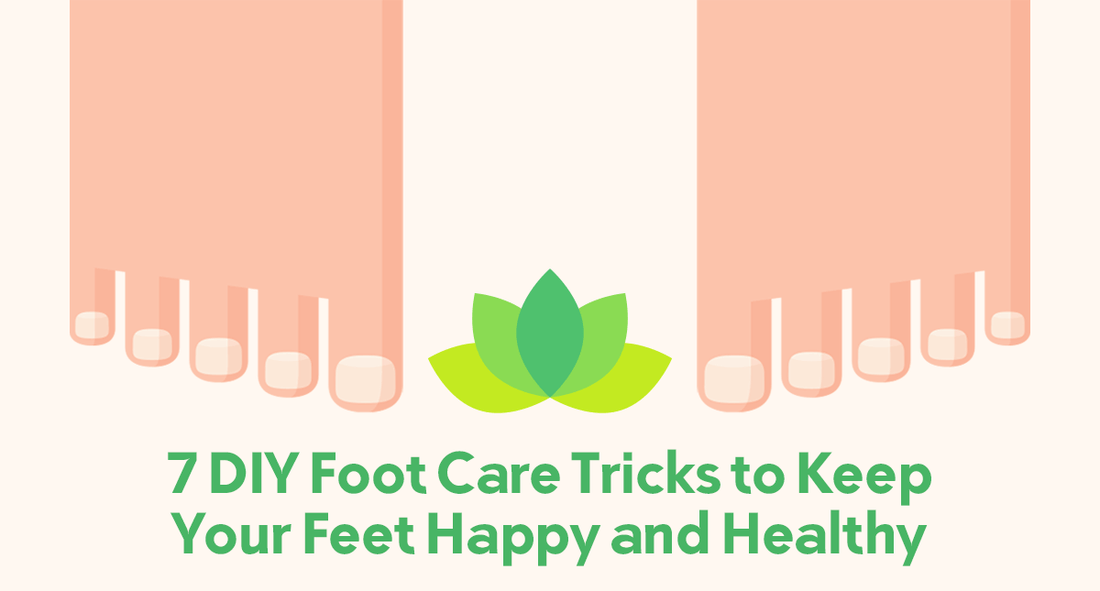7 DIY Foot Care Tricks to Keep Your Feet Happy and Healthy
- Foot Care
- Healthy Feet

Foot pain can be a real pain! There are many different problems that can cause pain and negatively affect your feet and ankles. While we here at Dr. Frederick’s Original have a number of affordable products for taking care of your feet, sometimes the simplest course involves no products at all. Below are some of our favorite DIY ways to care for your feet.

1. Stretch
Stretching is the easiest thing you can do to help the soft tissues of your foot, and to avoid plantar fasciitis, tendinitis, and Achilles tendon ruptures. It is important to stretch before any physical activities, but it is just as important to stretch regularly throughout the day.
The best way to stretch the calf for both Achilles problems and plantar fasciitis, is to stand with your toes on a step and your heels off the step. Then slowly lower your heels below the level of the step. This should be done for approximately 10 minutes 3-4 times daily. This is called eccentric stretching because the muscle contracts as it elongates.
For plantar fasciitis, it is also recommended to stretch before even getting out of bed. Mornings tend to be the most painful for plantar fasciitis sufferers, and taking a few minutes to rotate the ankle and stretch the feet can go a long way toward making the day easier. Try stretching the ankle by tracing the alphabet with your foot!

2. Eat a Healthy Diet
This doesn’t seem like an obvious answer to solving any foot problems, but it’s very relevant to foot health. Maintaining a healthy weight means your feet will have less pressure on them, making it less painful to walk throughout the day.
Diseases such as diabetes and peripheral artery disease play a huge role in foot health. Preventing these illnesses by eating a balanced diet will go a long way to ensure your feet are healthy. Diabetes is partially genetic and partially the result of eating excess sugar. Patients with diabetes often have neuropathy, or trouble feeling their feet. This can lead to accidentally stepping on something without knowing it, which develops into a foot ulcer. Once these ulcers develop, they can become infected and be difficult to treat. In extreme cases it can even lead to amputation.
Peripheral artery disease means there isn’t enough blood flow to the feet. It develops when plaque builds up in your arteries. It can make your feet feel cold and turn a blue-purple color. This means your feet don’t get enough nutrients to stay healthy. Peripheral artery disease can also cause delays in healing any injuries, making the combination of diabetes and peripheral artery disease especially risky.

3. Cut Toenails Properly
The best way to cut your nails is straight across without any curving. Doing this will prevent potential pain and complications from ingrown toenails. It also helps keep you from accidentally cutting yourself. If you need assistance, check to see if your insurance covers nail trims from a podiatrist - many cover a visit every three months.

4. Ice or Heat Your Feet
Both ice and heat can soothe sore feet, but it’s important to know when to apply them. Heating is recommended in the case of mild superficial hematomas, or blood clots. To treat a mild hematoma, dip a cloth in warm water and lay it over the hematoma. This may also help relieve arthritis pain. Note that this works only for small, mild hematomas and if you are concerned about a deep blood clot you should see a doctor immediately.
For most other conditions, icing is generally recommended. In the case of trauma, applying ice wrapped in a towel to the area for 10 minutes every hour will help reduce bruising, swelling, and pain. Icing is also a popular option for plantar fasciitis. Many patients find it helpful to freeze a water bottle (or purchase special balls filled with water) and roll it under their foot. It’s best to do this immediately following your plantar fasciitis stretches.

5. Reduce Your Calluses
Calluses, especially on the bottom of the foot, develop because there is excess pressure at that site. A callus is an area of thickened skin, and they can cause intense pain - like walking on a rock. The best way to reduce them is with a pumice stone, which you can find easily online or at your local drugstore. The ideal time to use a pumice stone is immediately following a warm shower or bath. The shower will soften your skin, allowing you to easily and gently rub the pumice stone over any calluses or thickened skin. Make sure not to be too aggressive and cause any wounds, especially if you have neuropathy and can’t feel your feet.

6. Lotion Your Feet
Pamper your feet with a moderate amount of lotion, ideally twice daily. Moisturizing your feet is a simple step to prevent dry skin. Dry skin can lead to calluses and fissures, which can ultimately lead to ulcers, especially in patients with neuropathy. Apply lotion after using a pumice stone for best absorption. If calluses are bothering you, try a lotion with 40% urea in it. This helps remove the excess skin cells of calluses.

7. Elevate Your Legs
Elevating your legs is a great easy way to help blood and lymph flow, keeping your feet healthy. This can be especially helpful in patients with conditions such as chronic kidney disease, lymphedema, or injuries. It can also reduce lower leg swelling, and foot pain from increased activity. We recommend elevating your legs above the level of your heart for 30 minutes, ideally 2-4 times daily. Please note that you should NOT elevate your legs if you have congestive heart failure as it will increase the load on your heart.
***
So there you have it! Seven easy things you can do at home to help your feet, and your whole body, feel better. Take care of your feet and they’ll take care of you.
Author: Dana Gustafson, DPM
Continue Reading
View All
Get the Heel Outta Here: Causes & At-Home Treatment for Dry, Cracked Heels
Heel fissures cause dry, cracked heels that can lead to pain and discomfort. Learn the causes of yellow, crusty heels...
- Dry Cracked Heels
- Healthy Feet
- Heel Pain
7 DIY Foot Care Tricks for Happy Healthy Feet (Video)
We present 7 at-home DIY ways to take care of your feet. Keep your feet healthy, pampered, and happy! Banish foot pai...
- Foot Care
- Healthy Feet
- Pain Relief
Managing Plantar Fasciitis
Plantar fasciitis can cause uncomfortable and debilitating foot pain. Explore causes and symptoms of this common foot...
- Foot Care
- Foot Pain
- Plantar Fasciitis